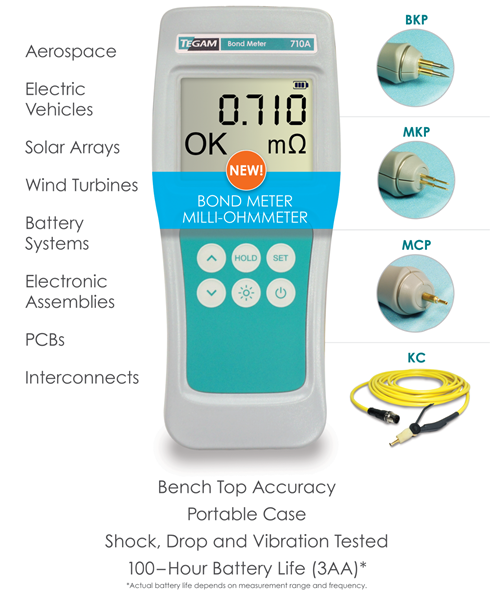How Accurate is Your Bond Meter? A Glimpse into the World of High-Accuracy Resistance Measurement
게시됨 2월 26, 2020 으로 Advanced Energy Editor
.png?lang=en-US) Bond meters are an important tool in any aircraft, automobile, or communications technician’s toolbox. Accurate bond measurements are critical to ensure the safe operation of these systems, and technicians look to instruments they can trust.
Bond meters are an important tool in any aircraft, automobile, or communications technician’s toolbox. Accurate bond measurements are critical to ensure the safe operation of these systems, and technicians look to instruments they can trust.
Bond Meters are resistance-measuring instruments that are designed specifically for grounding and bonding applications. In these applications, very small resistance values are desired. In fact, bond meters are often referred to as milli-ohmmeters and micro-ohmmeters to describe their ideal measurement ranges. They are generally fast-responding and easy to use for qualified technicians.
Behind the scenes, however, a complex system of extremely accurate resistance standards and detailed measurement processes are employed to ensure that quality bond meters meet the demands of the job. Below is an introductory description of just some of the considerations and challenges in the world of low-resistance measurement.
[1]At the primary standards laboratory there are usually several resistance standards that are calibrated/certified at a national laboratory. Several standards are required because in order to obtain the highest accuracy locally, the scaling errors can be reduced by using multiple standards. These standards typically require a highly temperature-stabilized oil bath facility and an accurate platinum resistance thermometer to monitor the temperature. For the most accurate measurements, the calculations must account for the effects of barometric pressure at the time of measurement, so a barometric pressure measurement must be made. Of course, a very accurate comparator must be available, such as a DC Current Comparator Bridge. Using this type of equipment with skill can result in comparisons of less than one part per million in accuracy and a few parts in 100 million in resolution. Typically, the primary laboratory has more than one standard resistor. One or more can be used to send to the national laboratory periodically, and at least one should be a “resident” standard that stays under controlled conditions at all times. Using this approach the uncertainty caused by shipping effects can be detected or compensated for.
The utilization of Hamon Transfer Standards are useful in scaling the ohm and they can be certified by a national laboratory. Such a device is a group of resistive elements that consist of individual resistors that are of a decade value and are series-parallel connected internally. The total resistance of the device is a decade value. A commutator is used to externally parallel the internal elements in order to obtain a value that is one-hundredth of the total resistance. Hence, a device may give 1, 10 and 100; or 10, 100, 1000; or 100, 1000, 10000 ohms depending on its connection. At the primary standards laboratory level these are useful to obtain accurate scaling.
Scaling the ohm is not easily done if the best accuracy is required. A standard 10K ohm resistance standard is useful in scaling from one ohm to ten kilohms. This standard is a stable 10-kilohm resistor with a temperature-sensing element housed in a thermally lagged container, requiring no temperature control. By measuring the temperature, the resistance can be calculated using data supplied by the manufacturer.
Scaling downward from one ohm to .0001 ohm is even more difficult because of current and power limitations and voltage drop limitations. Therefore, having the national standards laboratory calibrate/certify the 0.001 or 0.0001 ohm resistance standard is useful and suggested so as to ensure high accuracy below one ohm.
One of TEGAM’s areas of engineering and manufacturing expertise is within our lines of bond meters and bond meter probes for various industries and applications. From our intrinsically safe (ATEX, UL & CSA) bond meters to our full line of milli-ohmmeters, you can trust TEGAM when your measurements really matter.
See and download our Application Note on Testing Aircraft Electrical Bonds, and contact us via our short form, email or phone with any questions you may have before purchasing our test & measuring instruments. Follow the link to see our new 710A bond meter and milli-ohmmeter (pictured above).
[1] Excerpted from Calhoun, R. (1994) Calibration & Standards, DC-40 GHz. Geneva, OH: TEGAM, Inc.
